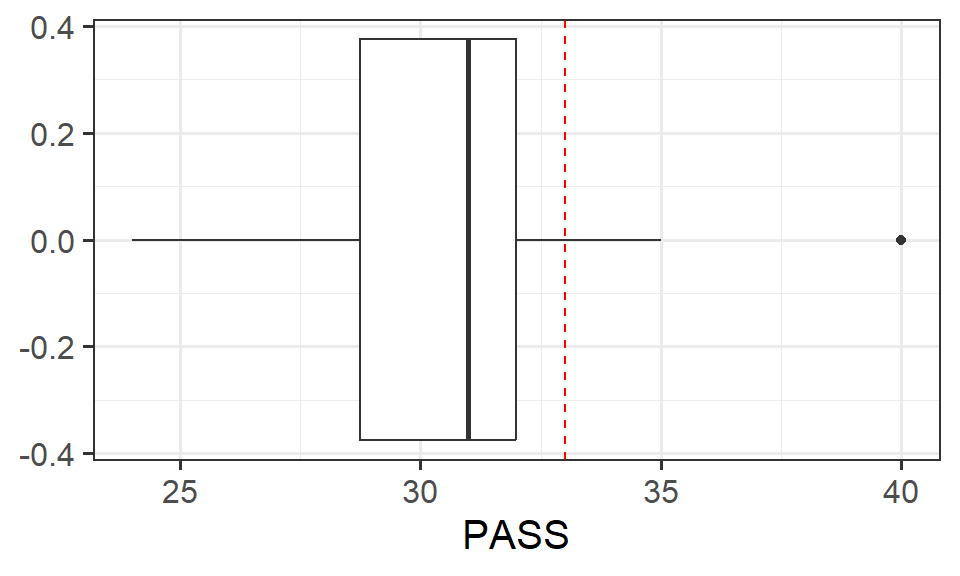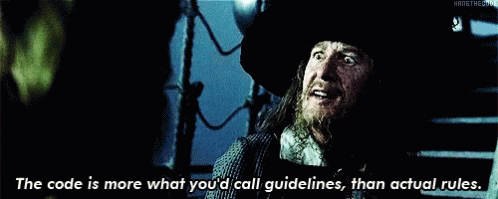qnorm(c(0.025, 0.975))[1] -1.959964 1.959964At the end of last week’s exercises, we estimated the mean sleep-quality rating, and computed a confidence interval, using the formula below.
\[ \begin{align} \text{95\% CI: }& \bar x \pm 1.96 \times SE \\ \end{align} \]
Can you use R to show where the 1.96 comes from?
qnorm! (see the end of Chapter 5 #uncertainty-due-to-sampling)
Solution 1. The 1.96 comes from 95% of the normal distribution falling within 1.96 standard deviations of the mean:
As we learned in Chapter 6 #t-distributions, the sampling distribution of a statistic has heavier tails the smaller the size of the sample it is derived from. In practice, we are better using \(t\)-distributions to construct confidence intervals and perform statistical tests.
The code below creates a dataframe that contains the number of books read by 7 people in 2024.
(Note tibble is just a tidyverse version of data.frame):
Calculate the mean number of books read in 2024, and construct an appropriate 95% confidence interval.
Solution 2. Here is our estimated average number of books read:
And our standard error is still \(\frac{s}{\sqrt{n}}\):
With \(n = 7\) observations, and estimating 1 mean, we are left with \(6\) degrees of freedom.
For our 95% confidence interval, the \(t^*\) in the formula below is obtained via:1
Our confidence interval is therefore:
\[
\begin{align}
\text{CI} &= \bar{x} \pm t^* \times SE \\
\text{95\% CI} &= 14.286 \pm 2.447 \times 2.652 \\
\text{95\% CI} &= [7.80,\, 20.78] \\
\end{align}
\]
Will a 90% confidence interval be wider or narrow?
Calculate it and see.
Solution 3. A 90% confidence interval will be narrower:
\[ \begin{align} \text{CI} &= \bar{x} \pm t^* \times SE \\ \text{90\% CI} &= 14.286 \pm 1.943 \times 2.652 \\ \text{90\% CI} &= [9.13,\, 19.44] \\ \end{align} \]
The intuition behind this is that our level of confidence is inversely related to the width of the interval.
Take it to the extremes:
Imagine playing a game of ringtoss. A person throwing a 2-meter diameter hoop will have much more confidence that they are going to get it over the pole than a person throwing a 10cm diameter ring.
Research Question Do Edinburgh University students report endorsing procrastination less than the norm?
The Procrastination Assessment Scale for Students (PASS) was designed to assess how individuals approach decision situations, specifically the tendency of individuals to postpone decisions (see Solomon & Rothblum, 1984). The PASS assesses the prevalence of procrastination in six areas: writing a paper; studying for an exam; keeping up with reading; administrative tasks; attending meetings; and performing general tasks. For a measure of total endorsement of procrastination, responses to 18 questions (each measured on a 1-5 scale) are summed together, providing a single score for each participant (range 0 to 90). The mean score from Solomon & Rothblum, 1984 was 33.
A student administers the PASS to 20 students from Edinburgh University.
The data are available at https://uoepsy.github.io/data/pass_scores.csv
Solution 4.
We want to check that the data are close to normally distributed. This is especially relevant as we have only 20 datapoints here. The plot below makes it look like we may have one or two data points in the tails of the distribution that are further than we might expect.
But the Shapiro-Wilk test of \(p > .05\) indicates that we are probably okay to continue with our t-test
Our test here is going to have the following hypotheses:
Manually calculate the relevant test statistic.
Note, we’re doing this manually right now as it’s a useful learning process. In later questions we will switch to the easy way!
Solution 5.
Using the test statistic calculated in question above, compute the p-value.
pt() function.
Solution 6. We have 20 participants, so \(df=19\)
Now using the t.test() function, conduct the same test. Check that the numbers match with your step-by-step calculations in the previous two questions.
Check out the help page for t.test() - there is an argument in the function that allows us to easily change between whether our alternative hypothesis is “less than”, “greater than” or “not equal to”.
Solution 7.
One Sample t-test
data: pass_scores$PASS
t = -3.1073, df = 19, p-value = 0.0029
alternative hypothesis: true mean is less than 33
95 percent confidence interval:
-Inf 31.9799
sample estimates:
mean of x
30.7 The \(t\) statistic, our \(df\), and our \(p\)-value all match the calculations from the previous questions.
The simple t.test() approach even gives us a confidence interval! Well.. half of one! This is because we conducted a one-sided test. Remember that null hypothesis significance testing is like asking “does our confidence interval contain zero?”. With a one-sided test we only reject the null hypothesis if the test statistic is large in one direction, and so our confidence interval is one-sided also.
Create a visualisation to illustrate the results.
Solution 8.
ggplot(data = pass_scores, aes(x=PASS)) +
geom_boxplot() +
geom_vline(xintercept=33, lty="dashed", col="red")
Write up the results.
There are some quick example write-ups for each test in Chapter 6 #basic-tests
Solution 9.
A one-sided one-sample t-test was conducted in order to determine if the average score on the Procrastination Assessment Scale for Students (PASS) for a sample of 20 students at Edinburgh University was significantly lower (\(\alpha = .05\)) than the average score of 33 obtained during development of the PASS.
Edinburgh University students scored lower (Mean = 30.7, SD = 3.31) than the score reported by the authors of the PASS (Mean = 33). This difference was statistically significant (\(t(19)=-3.11\), \(p < .05\), one-tailed).
Research Question Is the average height of University of Edinburgh Psychology students different from 165cm?

Data: Past Surveys
In the last few years, we have asked students of the statistics courses in the Psychology department to fill out a little survey.
Anonymised data are available at https://uoepsy.github.io/data/usmr25survey_historical.csv
Note: this does not contain the responses from this year.
No more manual calculations of test statistics and p-values for this week.
Conduct a one sample \(t\)-test to evaluate whether the average height of UoE psychology students in the last few years was different from 165cm.
Make sure to consider the assumptions of the test!

Solution 10.
We’ll read in our data and check the dimensions and variable names
[1] 610 24 [1] "birthmonth" "height" "eyecolour"
[4] "catdog" "threewords" "year"
[7] "course" "in_uk" "gender"
[10] "optimism" "spirituality" "ampm"
[13] "sleeprating" "extraversion" "agreeableness"
[16] "conscientiousness" "emot_stability" "imagination"
[19] "loc" "phone_unlocks" "caffeine"
[22] "caffeine_type" "procrastination" "multitasking" The shapiro.test() suggests that our assumption of normality is not okay!
(the p-value is \(<.05\), suggesting that we reject the hypothesis that the data are drawn from a normally distributed population)
Shapiro-Wilk normality test
data: surveydata$height
W = 0.99081, p-value = 0.0008986However, as always, visualisations are vital here. The histogram below doesn’t look all that great, but the t.test is quite robust against slight violations of normality, especially as sample sizes increase beyond 30, and our data here actually looks fairly normal (this is a judgement call here - over time you will start to get a sense of what you might deem worrisome in these plots!).
ggplot(data = surveydata, aes(x = height)) +
geom_histogram(binwidth=2) +
# adding our hypothesised mean
geom_vline(xintercept = 165) 
We can also take a quick look at the QQplot. The points follow the line closely apart from at the tail ends, matching the heavier tails of the distribution that are visible in the histogram above.
The data are not very skewed, and together with the fact that we are working with a sample of 597, i feel fairly satisfied that the \(t\)-test will lead us to valid inferences.
Research Question Can a server earn higher tips simply by introducing themselves by name when greeting customers?
Researchers investigated the effect of a server introducing herself by name on restaurant tipping. The study involved forty, 2-person parties eating a $23.21 fixed-price buffet Sunday brunch at Charley Brown’s Restaurant in Huntington Beach, California, on April 10 and 17, 1988.
Each two-person party was randomly assigned by the waitress to either a name or a no-name condition. The total amount paid by each party at the end of their meal was then recorded.
The data are available at https://uoepsy.github.io/data/gerritysim.csv
(This is a simulated example based on Garrity and Degelman (1990))
Conduct an independent samples \(t\)-test to assess whether higher tips were earned when the server introduced themselves by name, in comparison to when they did not.
alternative = ??.var.test() function.
Solution 11.
[1] 40 3# A tibble: 6 × 3
paid condition party
<dbl> <chr> <dbl>
1 28.5 name 1
2 27 no name 2
3 24.1 no name 3
4 28 name 4
5 30 name 5
6 27.5 name 6It might be nice to conduct our analysis on just the tip given, and not the $23.21 meal price + tip.
According to these tests, we have normally distributed data for both groups, with equal variances.
Shapiro-Wilk normality test
data: tipdata$tip[tipdata$condition == "name"]
W = 0.96267, p-value = 0.5985
Shapiro-Wilk normality test
data: tipdata$tip[tipdata$condition == "no name"]
W = 0.94405, p-value = 0.2857
F test to compare two variances
data: tip by condition
F = 1.9344, num df = 19, denom df = 19, p-value = 0.1595
alternative hypothesis: true ratio of variances is not equal to 1
95 percent confidence interval:
0.7656473 4.8870918
sample estimates:
ratio of variances
1.93437 Because the variances do not appear to be unequal, we can actually use the standard t-test with var.equal = TRUE if we want. However, we’ll continue with the Welch t-test.
Remember that our alternative hypothesis here is that the average tips in the “name” condition is greater than in the “no name” condition.
R will take the levels in order here (alphabetically), and assume that the alternative is for that group, so we use alternative = "greater" here to say that the alternative is \(\text{name}-\text{no name} > 0\).
Welch Two Sample t-test
data: tip by condition
t = 3.4117, df = 34.502, p-value = 0.0008314
alternative hypothesis: true difference in means between group name and group no name is greater than 0
95 percent confidence interval:
0.8893105 Inf
sample estimates:
mean in group name mean in group no name
4.9450 3.1825
Here are a few extra questions for you to practice performing tests and making plots:
Are dogs heavier on average than cats?
Data from Week 1: https://uoepsy.github.io/data/pets_seattle.csv
Solution 12.
In this case, we want to test whether \(dogs > cats\). What we are testing then, whether \(dogs - cats > 0\) or \(cats - dogs < 0\).
By default, as the species variable is a character, it will use alphabetical ordering, and t.test() will test \(cats - dogs\). So we want our alternative hypothesis to be “less”:
An alternative is to set it as a factor, and specify the levels in the order we want:
Which would then allow us to shove that into the t.test() and perform the same test, but using \(dogs - cats\) instead.
Welch Two Sample t-test
data: weight_kg by species2
t = 92.4, df = 1335.2, p-value < 2.2e-16
alternative hypothesis: true difference in means between group Dog and group Cat is greater than 0
95 percent confidence interval:
15.60965 Inf
sample estimates:
mean in group Dog mean in group Cat
20.377489 4.484731
Is taking part in a cognitive behavioural therapy (CBT) based programme associated with a greater reduction, on average, in anxiety scores in comparison to a Control group?
Data are at https://uoepsy.github.io/data/cbtanx.csv . The dataset contains information on each person in an organisation, recording their professional role (management vs employee), whether they are allocated into the CBT programme or not (control vs cbt), and scores on anxiety at both the start and the end of the study period.
Solution 13. Because we’re testing the reduction in anxiety, we need to calculate it. By subtracting anxiety at time 2 from anxiety at time 1, we create a variable for which bigger values represent more reduction in anxiety
And we can then test whether \(cbt - control > 0\):
Welch Two Sample t-test
data: reduction by cbt
t = 2.5953, df = 56.621, p-value = 0.006007
alternative hypothesis: true difference in means between group cbt and group control is greater than 0
95 percent confidence interval:
0.2744051 Inf
sample estimates:
mean in group cbt mean in group control
1.0266667 0.2551724 And to make sure we’re getting things the right way around, make a plot:
Are students on our postgraduate courses shorter/taller than those on our undergraduate courses?
We can again use the data from the past surveys: https://uoepsy.github.io/data/usmr25survey_historical.csv
“USMR” is our only postgraduate course.
Solution 14.
surveydata <- read_csv("https://uoepsy.github.io/data/usmr25survey_historical.csv")
surveydata <- surveydata |>
mutate(
isPG = course=="usmr"
)
table(surveydata$isPG)
FALSE TRUE
240 370
Welch Two Sample t-test
data: height by isPG
t = -0.22703, df = 547.46, p-value = 0.8205
alternative hypothesis: true difference in means between group FALSE and group TRUE is not equal to 0
95 percent confidence interval:
-1.495371 1.185517
sample estimates:
mean in group FALSE mean in group TRUE
167.6006 167.7555
(Why 97.5? and not 95? We want the middle 95%, and \(t\)-distributions are symmetric, so we want to split that 5% in half, so that 2.5% is on either side. We could have also used qt(0.025, df = 6), which will just give us the same number but negative: -2.4469119)↩︎